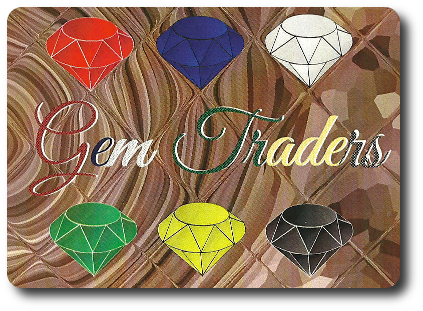
The Basics:
- For ages 6 and up (publisher suggests 12+)
- For 2 to 6 players
- Approximately 20 minutes to complete
Geek Skills:
- Counting & Math
- Logical & Critical Decision Making
- Reading
- Pattern/Color Matching
- Hand/Resource Management
- Bidding
Learning Curve:
- Child – Easy
- Adult – Easy
Theme & Narrative:
- Carefully bid to get just the right gems for maximum profit
Endorsements:
- Gamer Geek rejected!
- Parent Geek approved!
- Child Geek approved!
Overview
Johnny Lingo, a fictional character in a short film with the same title, said “The more you’re willing to pay, the more valuable the prize. The question is: Are you willing to pay the price?” Players will be tasked to collect certain “gems”, but the value of each is different for every player. What looks to be of great value to one person is worthless to another. The real question is, are you willing to pay more to get something of less value simply to win the game?
Gem Traders, designed by Mark and Sydney Faulstich and published by Thundarg Games via the Game Crafter, is comprised of 1 Gem Trader mat, 36 Gem dice (standard six-sided dice in 6 different colors, 6 per color), 20 Player cards, 6 Bidding cards, 60 Money tokens, 20 Power tokens, and 6 Player Screens. The cards are as thick as your standard playing card, as is the Gem Trader mat. The tokens are plastic discs and the Power tokens are small polished stones. The dice are your standard six-sided variety that you find in most games. Overall, the game’s presentation is not much to look at, but it does the job.
Game Set Up
To set up the game, first place the Gem Trader mat in the middle of the playing area. All players should be able to easily reach this mat from their sitting position.
Second, give each player 1 Player Screen, 1 Bidding card, 2 Power tokens, and 10 Money tokens. Place the remaining tokens next to the Gem Trader mat. This is the Bank for the duration of the game. Any leftover Player Screens and Bidding cards should be returned to the game box.
Third, shuffle the Player cards and deal 1 out to each player, face-down. Players should look at their card, but keep it hidden from their opponents until the end of the game. This card tells the player how they can score points at the end of the game, but more on this later. Return any unused Player cards to the game box.
Fourth, divide the Gem dice into 6 different groups. Each group will have 1 color of each of the 6 Gem dice. The gems are as follows:
- Rubies (the red dice)
- Sapphires (the blue dice)
- Diamonds (the white dice)
- Emeralds (the green dice)
- Topaz (the yellow dice)
- Onyx (the black dice)
This completest the game set up. Determine who will go first and begin.
Bling Bling
Gem Traders is played in rounds with a total of 6 rounds per game. Each player will have a chance to roll a dice group on their turn. When they do, they are referred to as the “Roller”. A typical round is summarized here.
Note: At all times, the rolled dice values should NEVER be changed unless they are altered by a Bid Flip.
Step 1: Roller Rolls One Group
The Roller for the round takes one of the unrolled groups and rolls all 6 dice. The Roller must select 1 die color to discard from the roll. The Gem Trader mat has 1 space for each Gem die that matches the dice color being discarded. The Roller is welcome to select any color they like as long as it has not been selected during a previous round.

The remaining 5 dice are placed in one of the 5 spaces in the center of the Gem Trader mat referred to as the “Auction Block”.
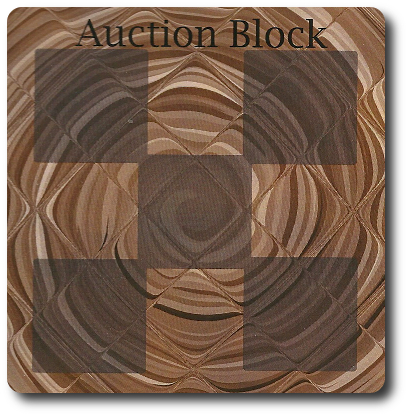
Step 2: Everyone Secretly Bids
All the players now place their Player Screen in front of their Bidding card so their opponents cannot see how they are bidding for the available Gem dice. The Bidding card has an image of each of the 6 Gem dice types. Players will place their tokens on these images to represent how much they are bidding to claim the available Gem dice for this round. Discarded dice cannot be bid on.
A player has 3 different bid types. They are as follows:
- Money Bid: The player uses their Money tokens and places them on one or more images on their Bidding card.
- Bid Flip: The player uses their Money tokens and 1 Power token, placing them on one or more images on their Bidding card. A Bid Flip allows the player, if they win the bid, to change the rolled values of the die. A “1” becomes a “6” and a “2” becomes a “5”.
- Bid Steal: The player uses 1 Power token only and will take the Gem die and any Money and Power tokens their opponents use for the specified gem this round.
All bids are placed, directly on the color matching the gems the player is hoping to win.
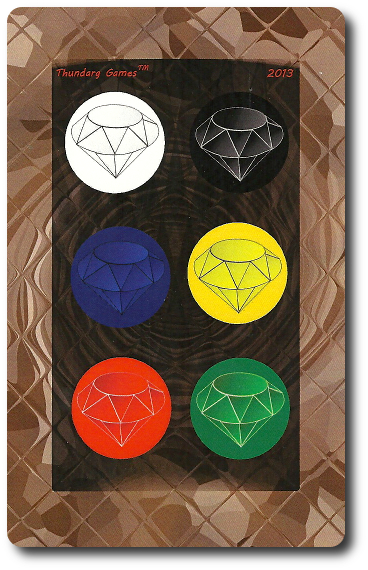
Only after all the players have completed their bids should the round continue to the next step.
Step 3: Reveal Bids and Award Gems
The Player Screens are now removed and the bids revealed. Determine the new owner of each of the gems in the Auction Block one at a time by comparing player bids on the Bidding cards.
- Bid Steals trump all other bids. The player who placed a Bid Steal not only collects the Gem die, but all the Money and Power tokens their opponents used for that specific gem bid.
- The player with the most Money tokens wins the gem for Money Bids and Bid Flips. If the player wins the bid with a Bid Flip, they change the die value when they collect the Gem die.
When players win the bid, they lose the Money and Power tokens they spent, returning them to the Bank. Players always keep their tokens if they lose the gem bid unless an opponent won a gem using a Bid Steal.
Bid ties for all 3 bid types always go the round’s Roller. If a bid for 2 or more players is tied, and the Roller is not part of the tie, the tied players now have an open bid. Players must increase their bid and always bid at least 1 higher than the previous bid. If they do not, they lose the bid. The player who bids the highest wins the gem.
Step 4: Sell Gems
Players can now sell unwanted gems back to the Bank. The gem is worth the die value in Money tokens. For example, a Gem die with a rolled value of “5” can be sold for 5 Money tokens. A player can also sell Gem die with a rolled value of “3” or “4” for 1 Power token. Gems sold are removed from the game.
Once all the bids have been resolved and gems given to their new owners or sold, the round ends. The next player in turn order sequence now goes, becoming the new Roller. His continues for a total of 6 rounds.
Winning the Game
The game ends after the 6th round is completed. All the players now reveal their Player card. The Player card defines how each player will earn points and each Player card is different. This means the players are all attempting to score points using different rules. The Player cards detail which Gem dice score and how. A few examples of scoring are provided here.
- Dx#: The player multiplies the Gem values (a Gem’s value is determine by the die value) by the number given. For example, “Dx3” would mean the player would multiply the total value of all the Gem die of a specific color by 3.
- (D-#)x3: The player subtracts the total by the number given and then multiplies the new value of all the Gem die of a specific color.
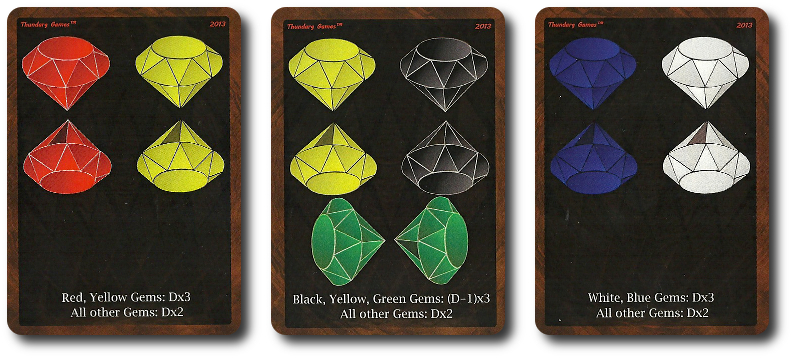
The player with the highest point value wins the game. Ties are broken by Money tokens.
Game Variants
To reduce player conflict (and hurt feelings), change the Bid Steal to a Power Bid. Power Bids always win (unless tied with another Power Bid). However, if a player wins using the Power Bid, their opponents keep their Money and Power tokens.
To learn more about Gem Traders, visit the game’s web page on the Game Crafter.
Prediction
Economic games tend to do pretty well with both the Gamer Geeks and the Parent Geeks. The Child Geeks understand the math, but not necessarily the value of the bits and pieces being bid on or being sold. This is why I like Economic games so much with the family. They teach my little geeks (and remind me) what the difference is between “perceived value” and “real value”. Games like Gem Traders challenge a player to balance what they want with what they have. Oftentimes, and in real life, players will find that their wants and needs are simply unobtainable and they must work harder and smarter to reach their goals.
I believe Gem Traders will do well with the Parent Geeks, but not as well with the Gamer Geeks. The game itself is a bit too repetitive and lacks a certain depth that will keep a Gamer Geek interested. It’s basically 6 rounds of the same thing with the only change being the dice values. You can skunk your opponent by buying up gems you “think” they might want, but doing so might hurt the player unless they are also are looking to collect that gem.
For the Child Geeks, I think it’ll be a mixed bag, too. The act of rolling dice is always found to be a fun experience and the math behind the trades is simple enough. What will confuse and possibly frustrated the Child Geeks is the way the dice are scored. Some of the Player cards are not altogether easy to understand. A simple reshuffle and re-deal of a Player card should fix this, however.
Teaching Gem Traders is best done by drawing a Player card at random and explaining to each player that what they want to focus on in the game are the dice that are on the card. At first, at any rate. It might become necessary to buy other gems to hurt opponents and it will most certainly be necessary to sell a gem or two. After that, give a quick demo of how players will bid and explain in as much detail as necessary the three different bid types. Note that this game does require its players to read. Each Player card needs to be kept secret from opponents at all times until revealed at the end for scoring. If a player cannot read or understand their Player card, they are going to be buying blind.
And so, after teaching Gem Traders to my two oldest Child Geeks, I asked them their thoughts on the game so far.
“I like that each of the gems is worth what the dice value is. That makes it easy to see which gems are more valuable.” ~ Liam (age 9)
“Easy math, Daddy, but the Player cards are confusing.” ~ Nyhus (age 6)
I had to re-deal 4 times until my 6-year-old was given a Player card that made sense to him. In hindsight, I should have just handed him the deck of Player cards to look through. Let’s play Gem Traders and see if the game is worth the roll of the dice.
Final Word
The Child Geeks surprised me and really showed genuine interest and enthusiasm whilst playing Gem Traders. I was originally concerned that the Player cards would cause problems, but as it turned out, they were an asset to the game. Most Economic games require the player to determine the value of what is being bid on and sold. Not the case for Gem Traders. The Player cards tells the player exactly what they want to get and exactly how much it’ll be worth. This served to guide the Child Geeks and help alleviate any doubt that their bids were worth the money being spent. With a higher level of confidence in their play, the Child Geeks enjoyed themselves all the more. According to one Child Geek, “I like this game because I know exactly what I am supposed to do.” Another Child Geek said, “The math can be hard and I don’t like how many times I have to go back and re-add my numbers, but I like the game a lot.” After the games were over, the Child Geeks voted to approve Gem Traders.
The Parent Geeks also enjoyed the game, finding it to be a fun and casual Economic game that included easy to follow rules and had relatively fast game play. The only aspect of the game they didn’t like was the possibility that an opponent could have a Player card that provided more points. I looked through a random sampling and did find that a few Player cards appeared to be offering more points than others. What stops me from suggesting that the game is somewhat unbalanced is the random dice rolls and the general overlap of the gems across multiple Player cards. During every one of our games, participants were going after the same dice with only a few gems not being hotly contested over. According to one Parent Geek, “This is a good game. Nothing to really get excited about, but I enjoyed myself.” Another Parent Geek said, “I like a good Dice game that requires thinking and not just mindless rolling.” All the Parent Geeks voted to approve the game.
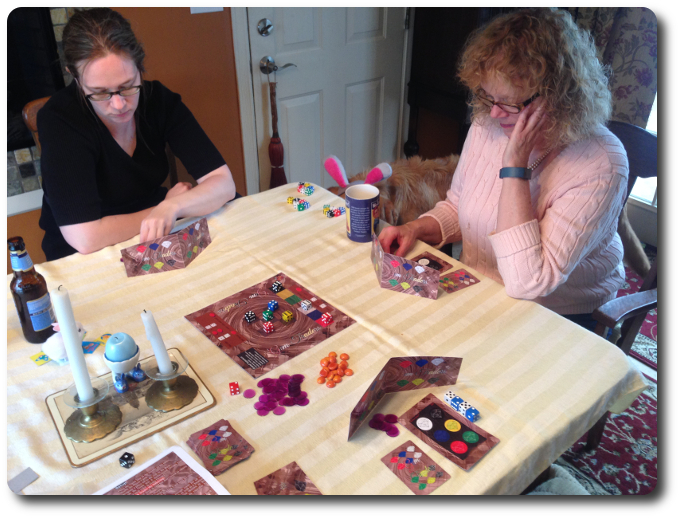
My wife and mom think about their bids during the third round of the game
The Gamer Geeks were not impressed with Gem Traders. According to one Gamer Geek, “This game is way too simple and way too repetitive. I am always going after the same dice, no matter what the value.” Another Gamer Geek said, “I like how the dice determine the gem value, but the hardest part about this game is simply having enough money. For a game that is all about buying, you tend to do a lot more selling.” All the Gamer Geeks voted to reject Gem Traders.
Gem Traders is what I would consider a good game for new and inexperienced players who know nothing about Economic games. It’s light, easy to follow, and the value of what is being collected is very clear. One of the trickier aspects of most Economic games is determining value. Gem Traders circumvents any confusion and flat-out tells the player what the dice are worth. In an interesting twist, each gem type is of slightly different value to each player, but only at the END of the game. This means that the gems are nowhere near the same perceived value. A diamond could be the most important thing to one player and worth absolutely nothing to their opponent.
If you are looking for a light and easy to learn game of dice and economics, do give Gem Traders a try.
This game was given to Father Geek as a review copy. Father Geek was not paid, bribed, wined, dined, or threatened in vain hopes of influencing this review. Such is the statuesque and legendary integrity of Father Geek.



